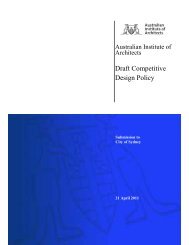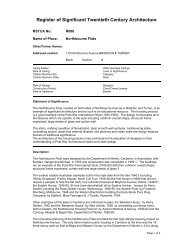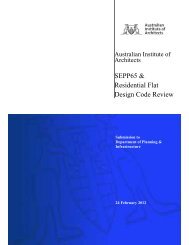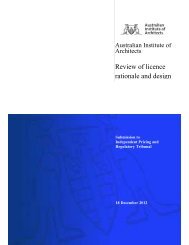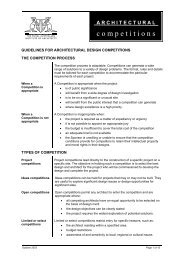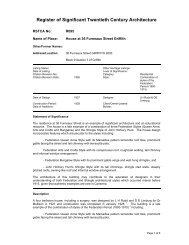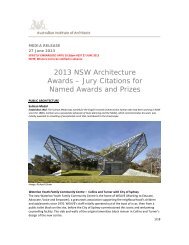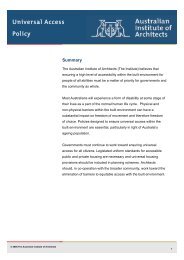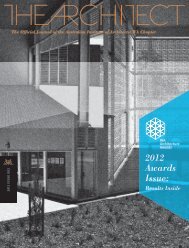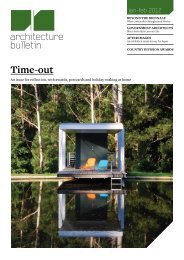Small Lots Housing Code - Australian Institute of Architects
Small Lots Housing Code - Australian Institute of Architects
Small Lots Housing Code - Australian Institute of Architects
Create successful ePaper yourself
Turn your PDF publications into a flip-book with our unique Google optimized e-Paper software.
We note the need for flexibility in building to the front boundary to allow for avariety <strong>of</strong> approaches to development within a specific street or precinctcontext. A maximum <strong>of</strong> 900mm should provide sufficient leeway to allow forthis difference.A review <strong>of</strong> the minimum lot area requirements contained in many LEPsshould be undertaken so as not to unnecessarily restrict the creation <strong>of</strong> smalllots in areas close to retail and public transport.4 ORIENTATIONOrientation is an issue on infill sites. It is as important that the new propertymakes use <strong>of</strong> its position on the lot for maximum solar access as it is toprevent it from encroaching on the solar access and privacy <strong>of</strong> its neighbours.It is recognised that this is difficult in the framework <strong>of</strong> the complying codes,as requiring a certain orientation may be contrary to the specific siteconditions. However the Department should encourage good orientationthrough the implementation <strong>of</strong> education material (discussed in 9 below).5 MINIMUM LOT AREA VS MINIMUM LOT WIDTHThe discussion paper seeks feedback on Page 6 regarding circumstanceswhere some lots may meet the minimum lot area requirement but not theminimum lot width requirement. The <strong>Institute</strong> considers that the solution to thisproblem, and to the problem <strong>of</strong> anomalies generally, is to apply only one <strong>of</strong>the criteria to each code, i.e. minimum lot area applies only to the generalhousing code and lot width requirements apply only to the small lot housingcode.6 HERITAGE CONSERVATION AREASThe <strong>Institute</strong> is confident that many <strong>of</strong> the developments in these areas thatcurrently require merit assessment could be encompassed by the codes,providing advice is sought from a council’s heritage advisor (where thisservice is provided) before lodging the application. A sensible balance can bestruck between the statutory force <strong>of</strong> the code and the provision <strong>of</strong> freeinformed advice to guide the owner’s practical and aesthetic decisions. Thiscould be managed through a pre-approval process - in a similar way togetting approval for a driveway or s68 approval.Many low-impact developments could be handled in this manner, usingvisibility from the public domain as the key criterion for determining whetherthe proposal should be approved. We understand that in a SEPP the use <strong>of</strong>such a discretionary term is difficult, and that further work needs to be done todefine this term. The public domain may encompass more than the view from<strong>Australian</strong> <strong>Institute</strong> <strong>of</strong> <strong>Architects</strong> (NSW)<strong>Small</strong> <strong>Lots</strong> <strong>Housing</strong> <strong>Code</strong>6 August 20104





